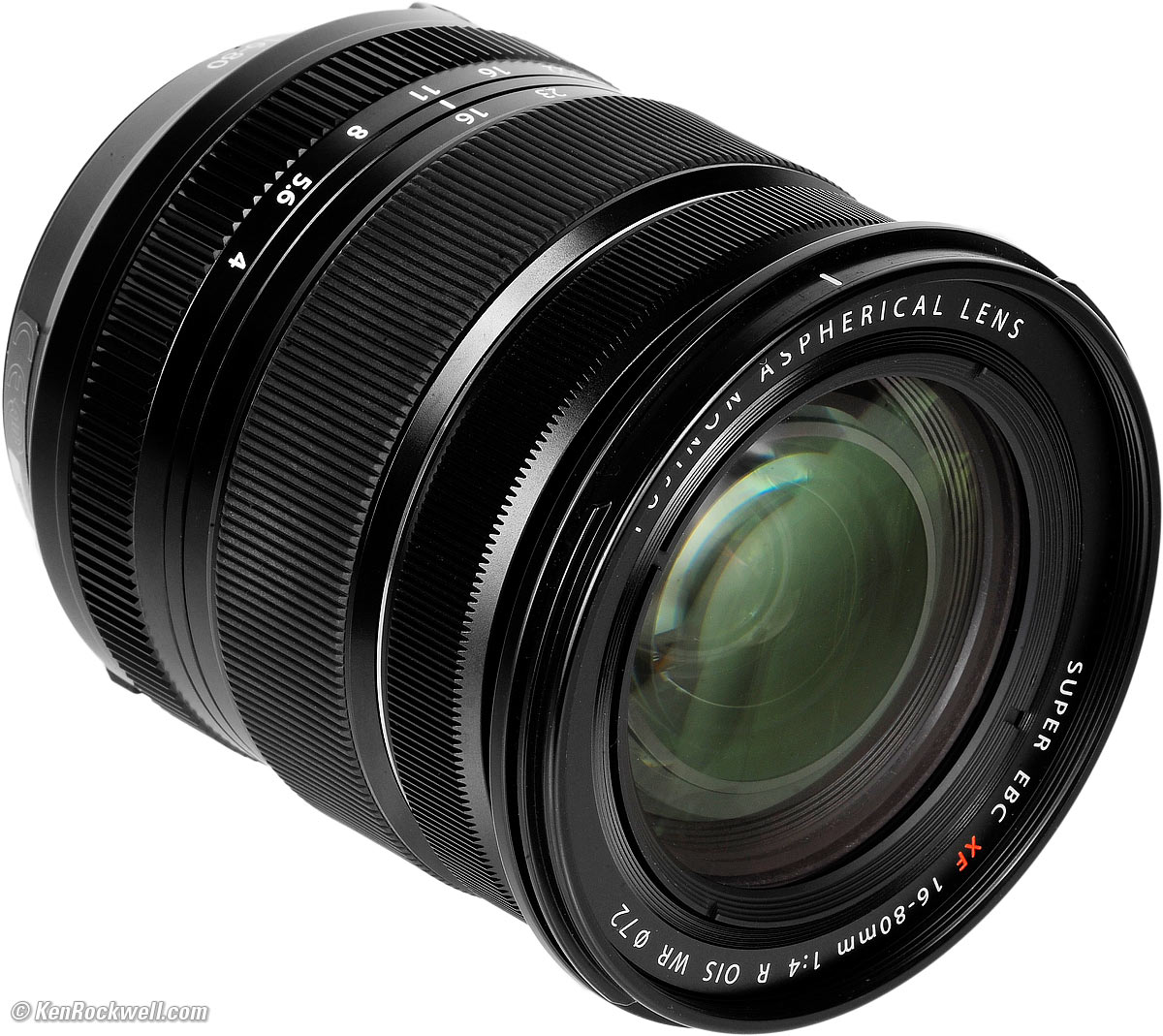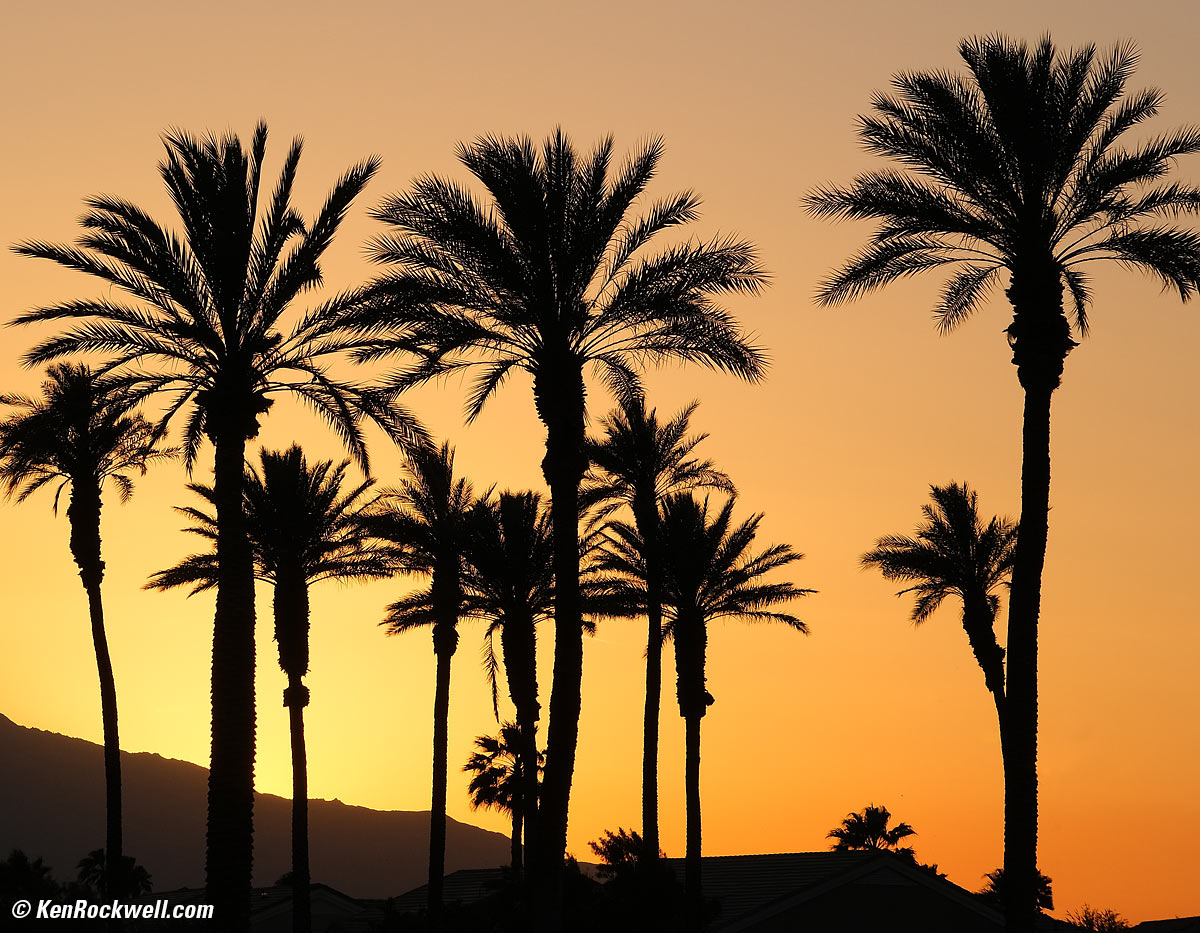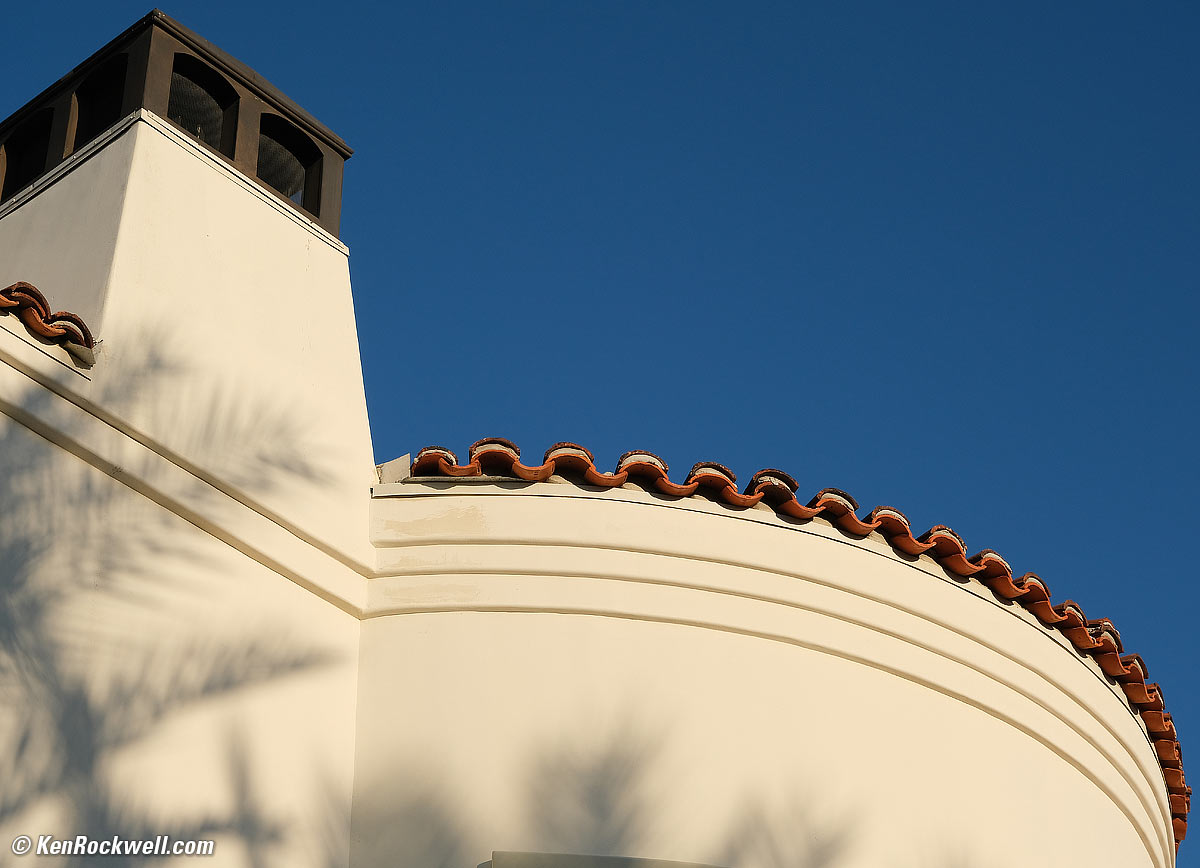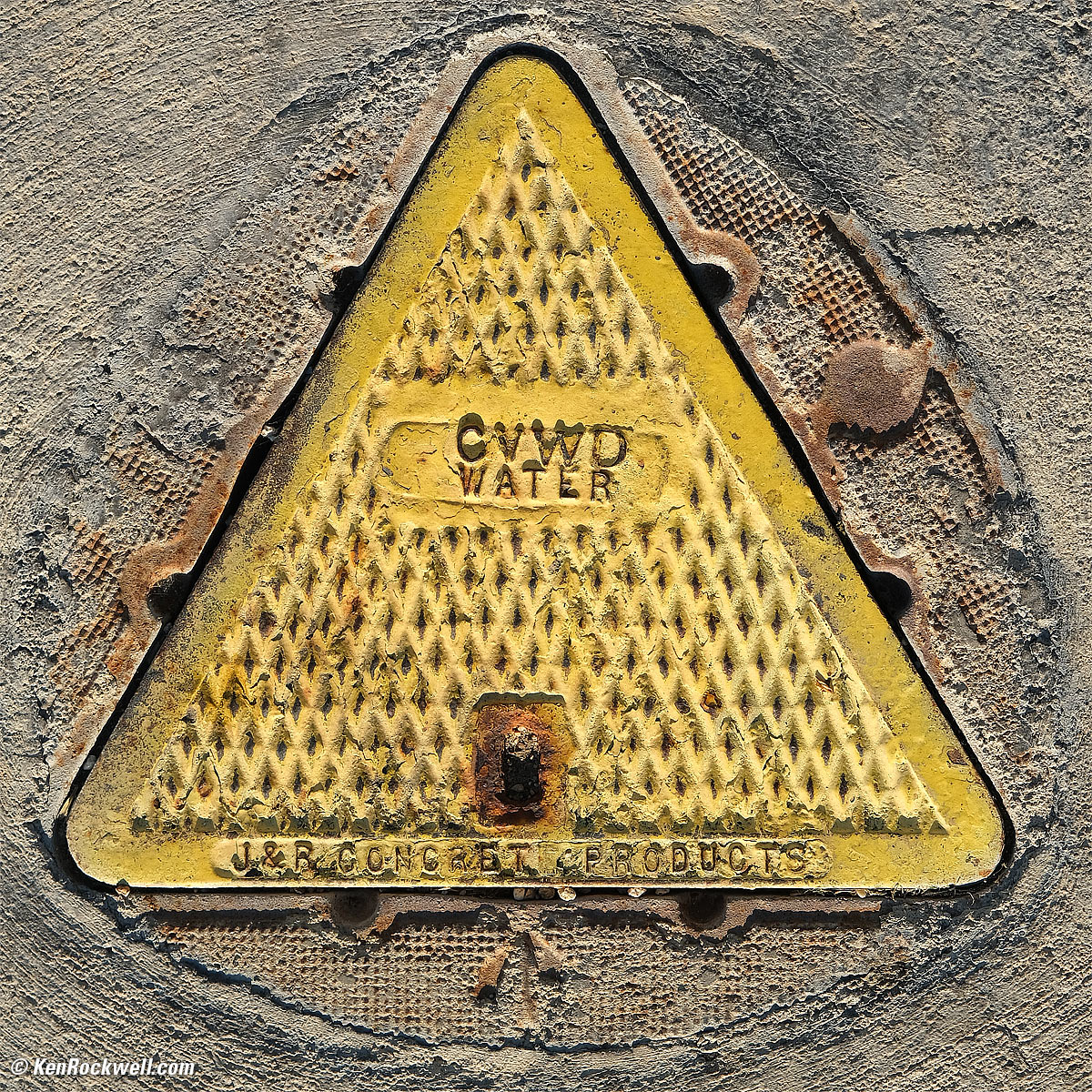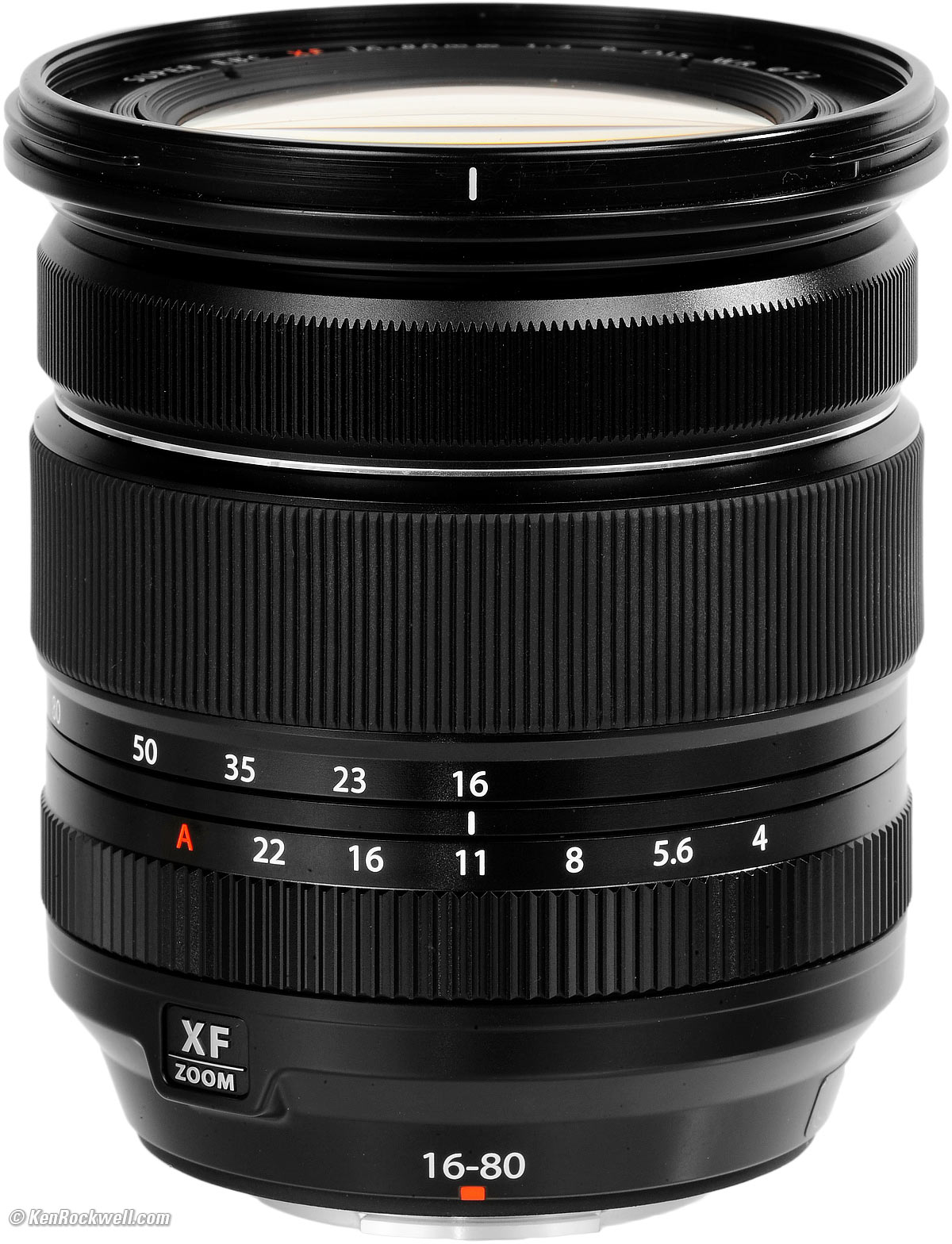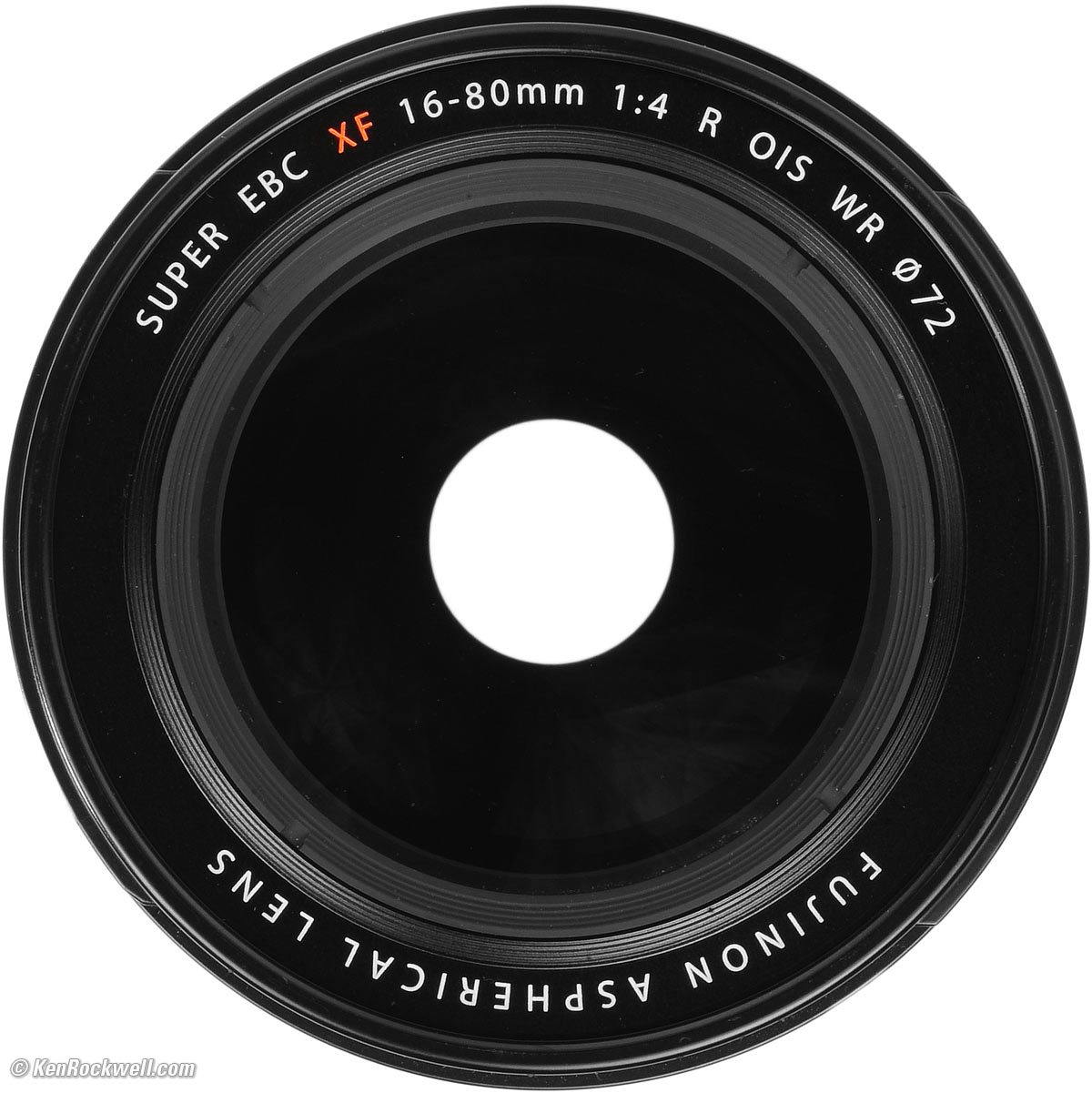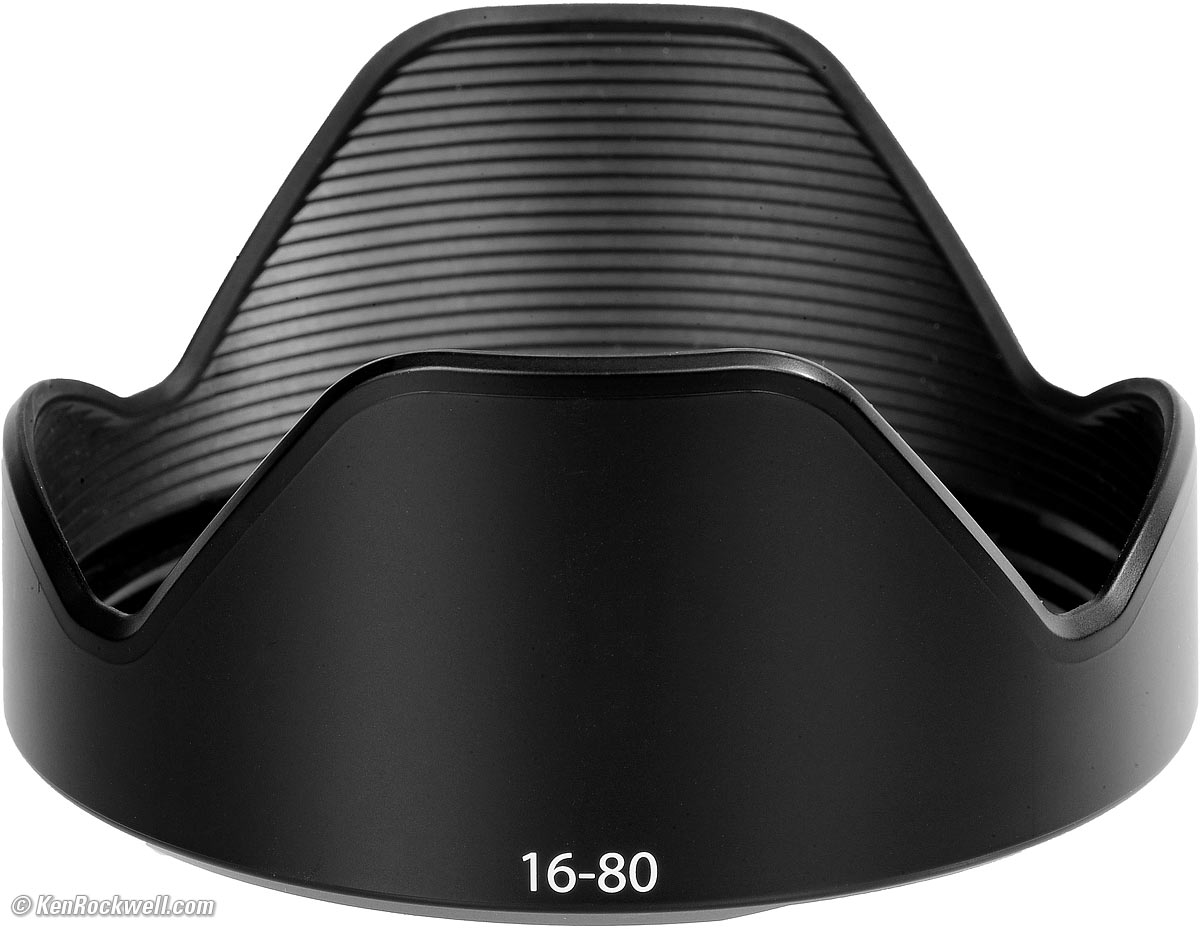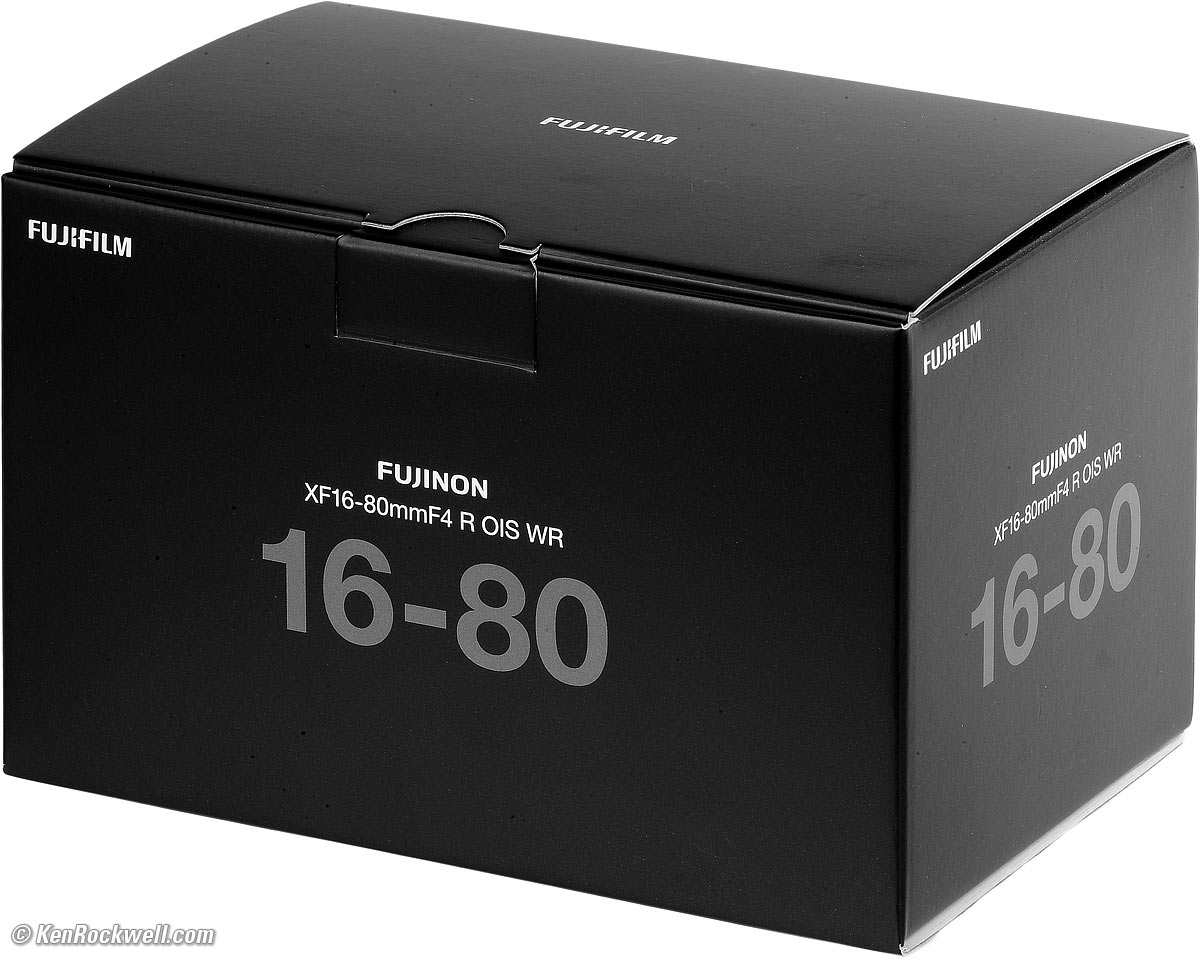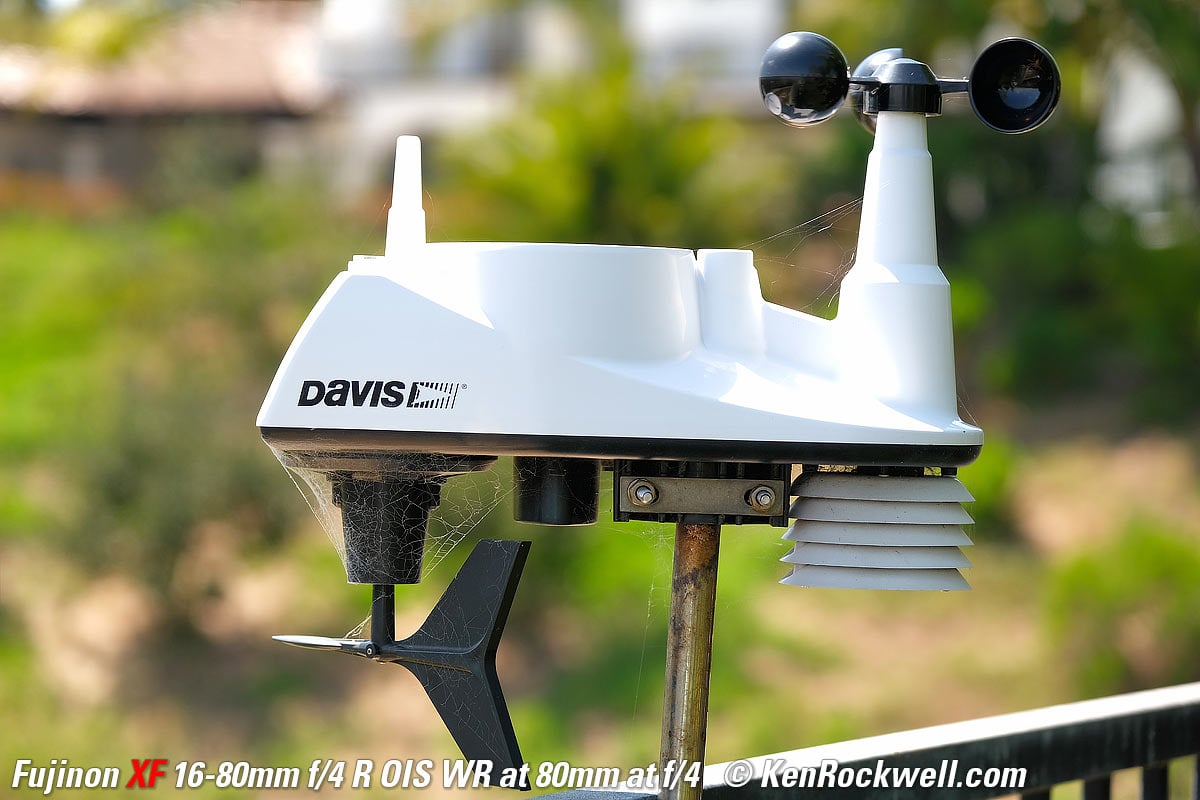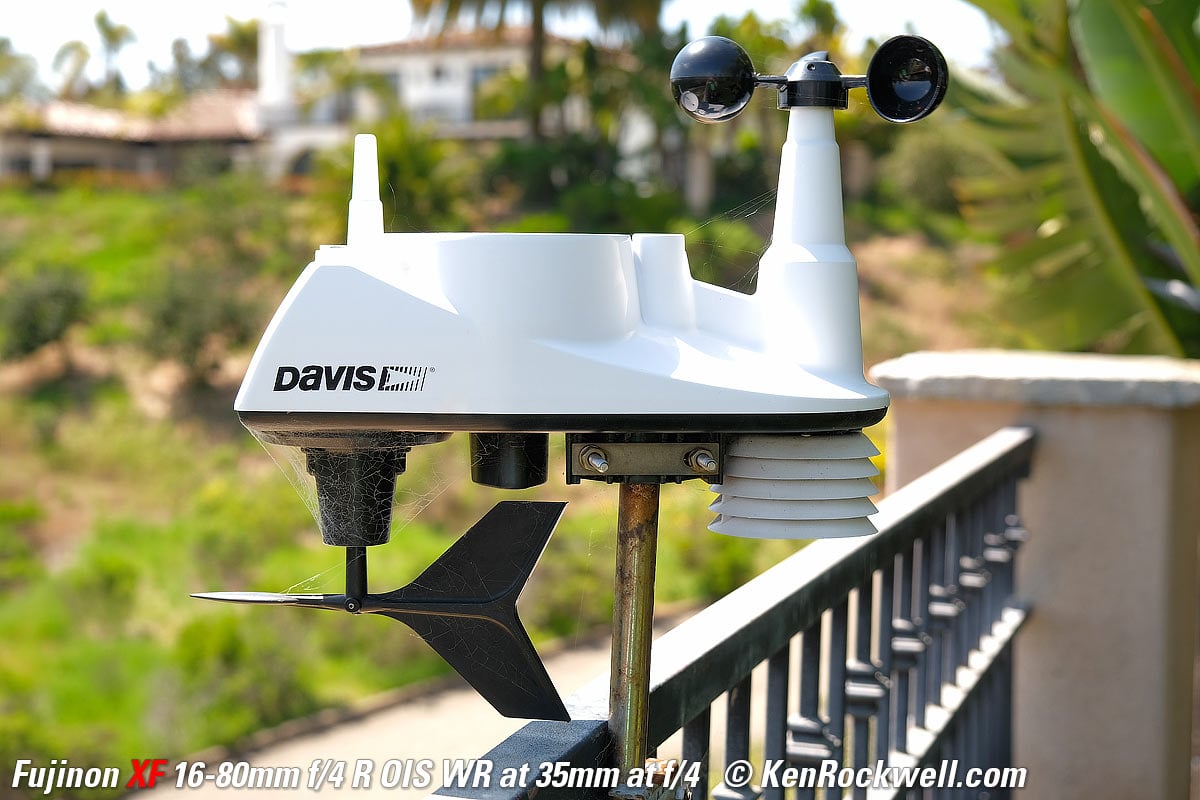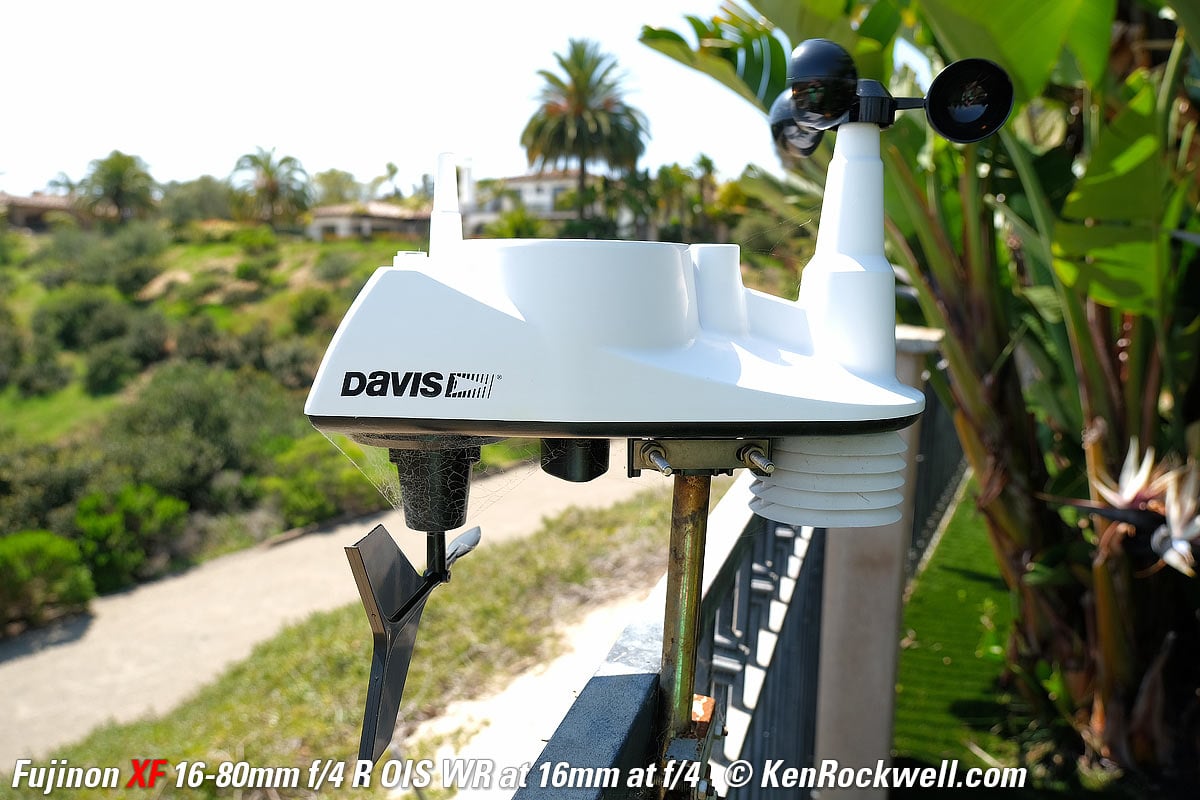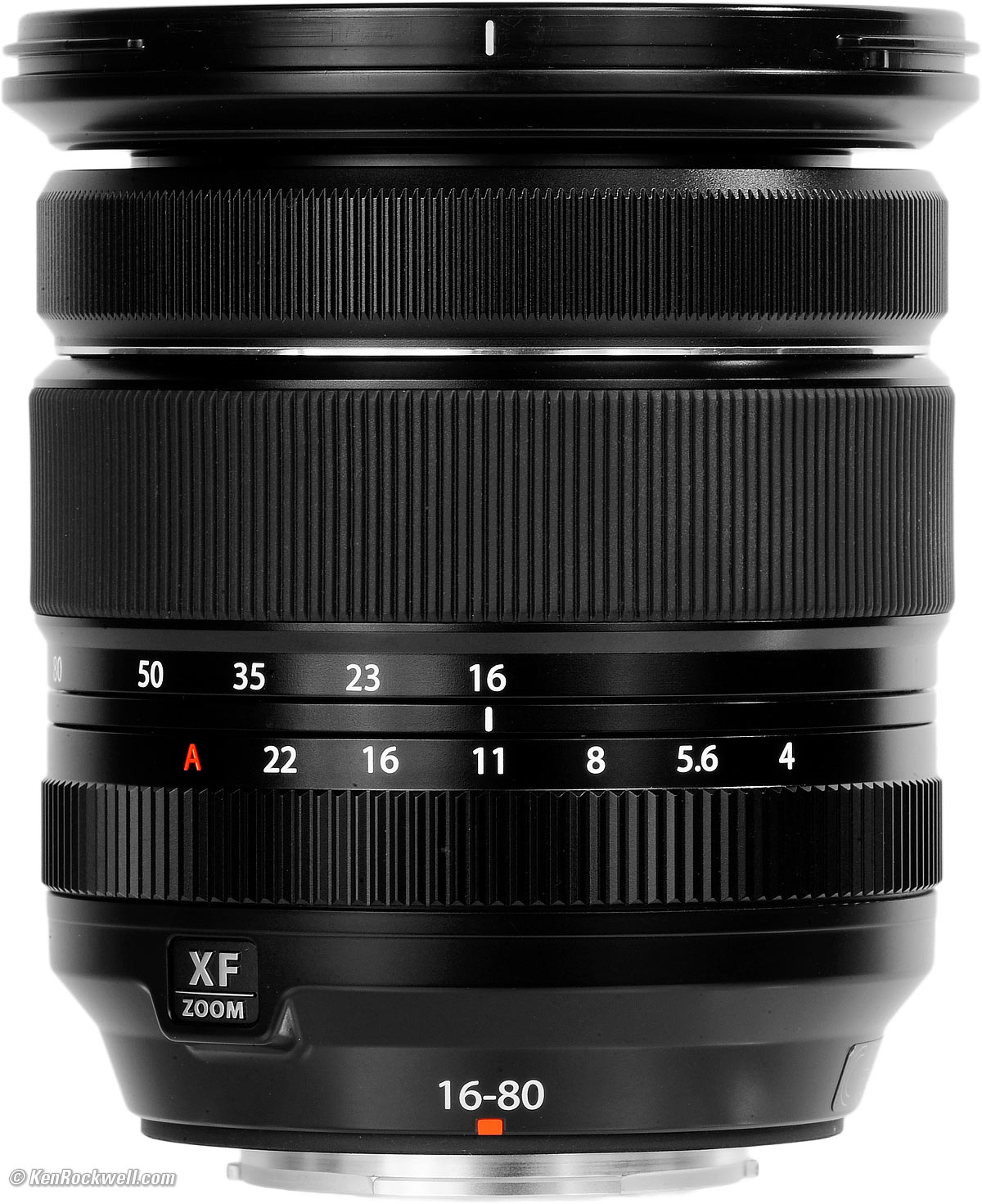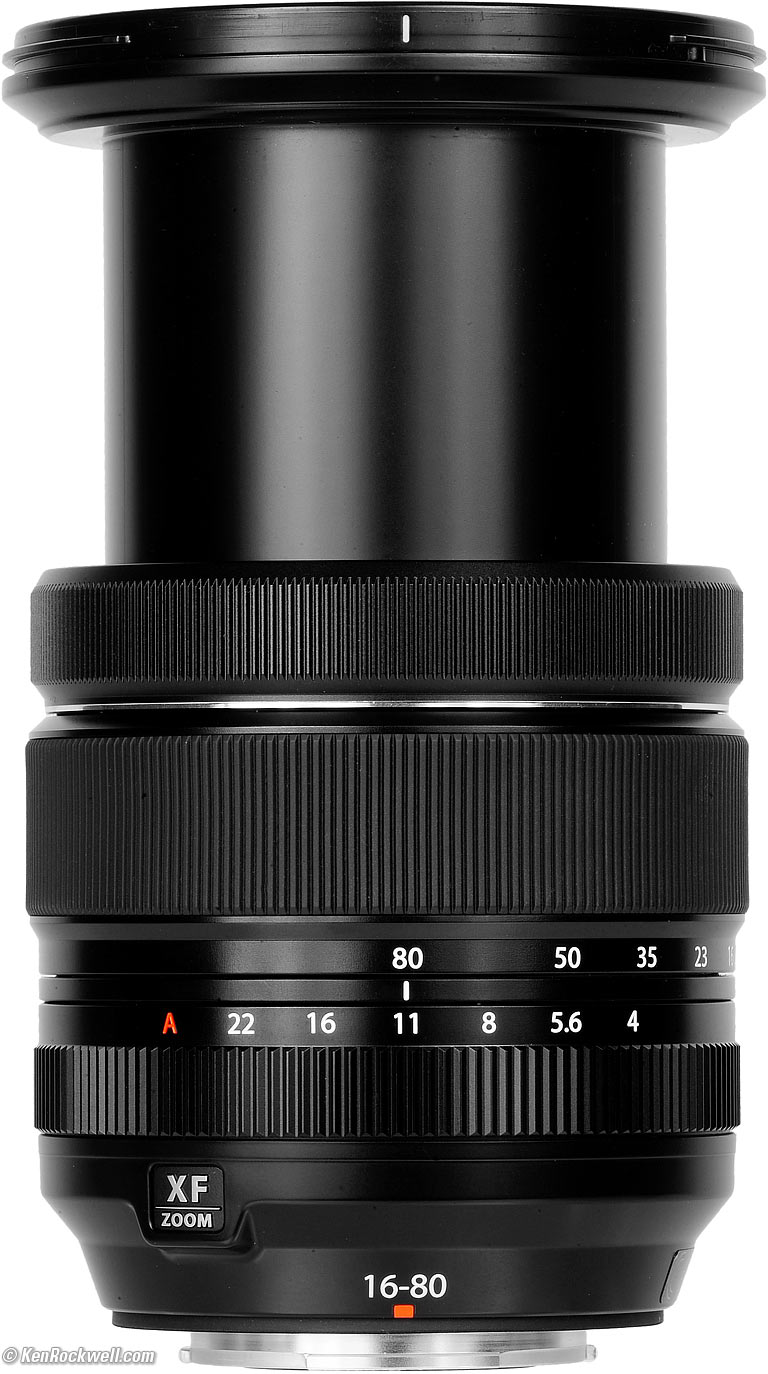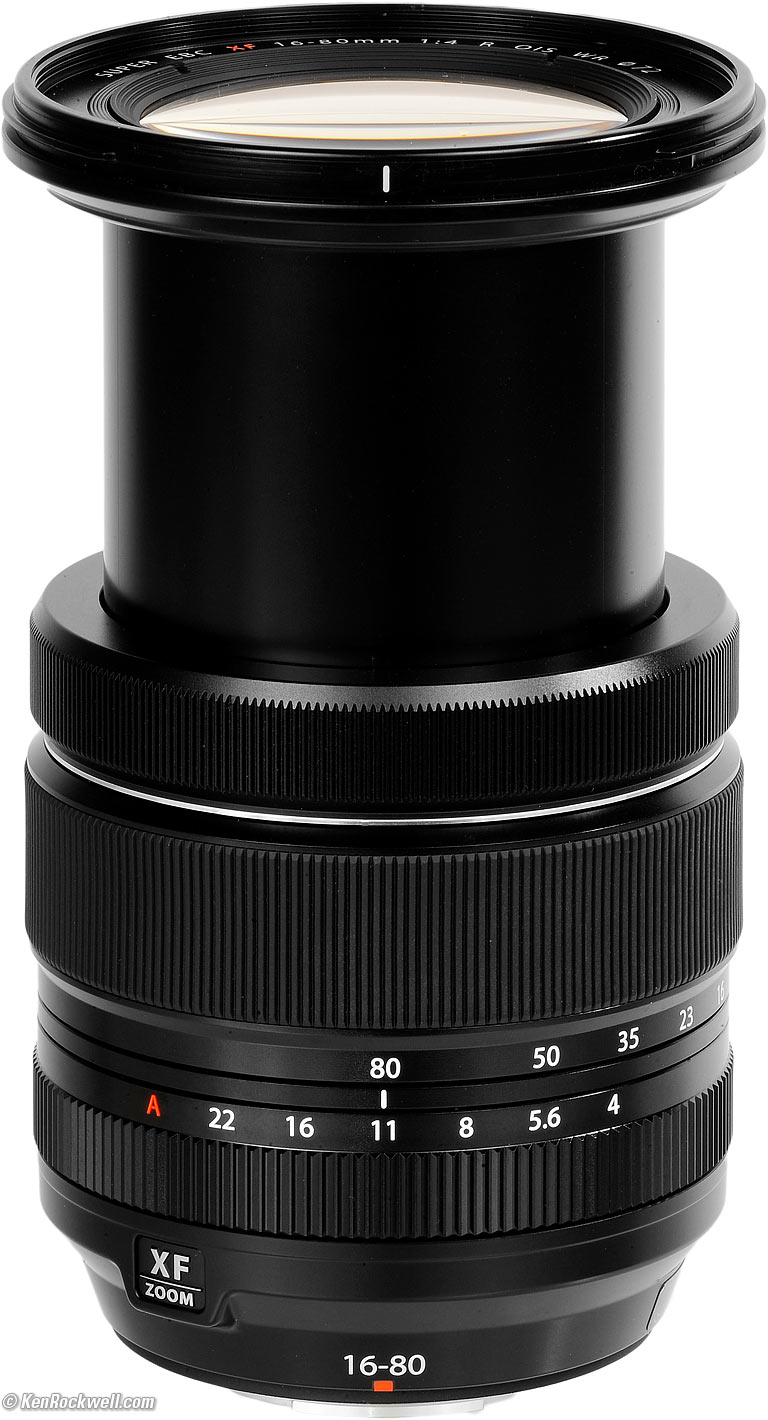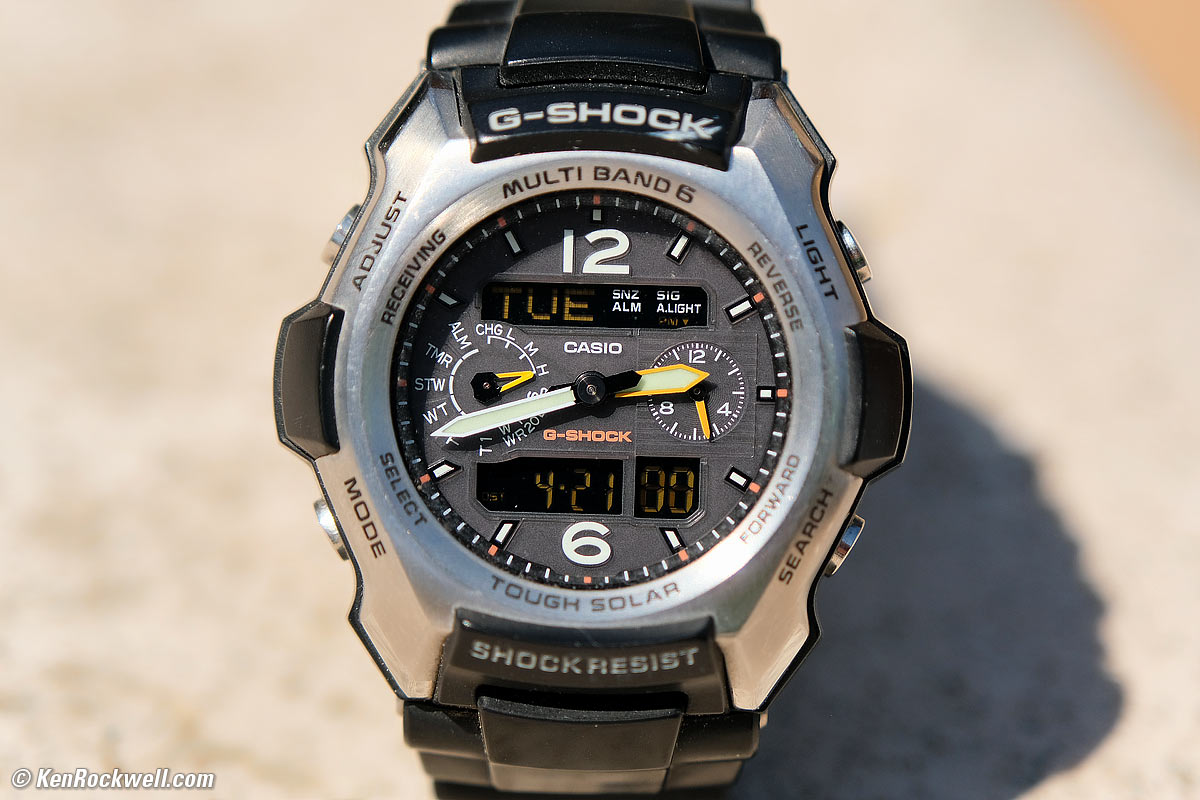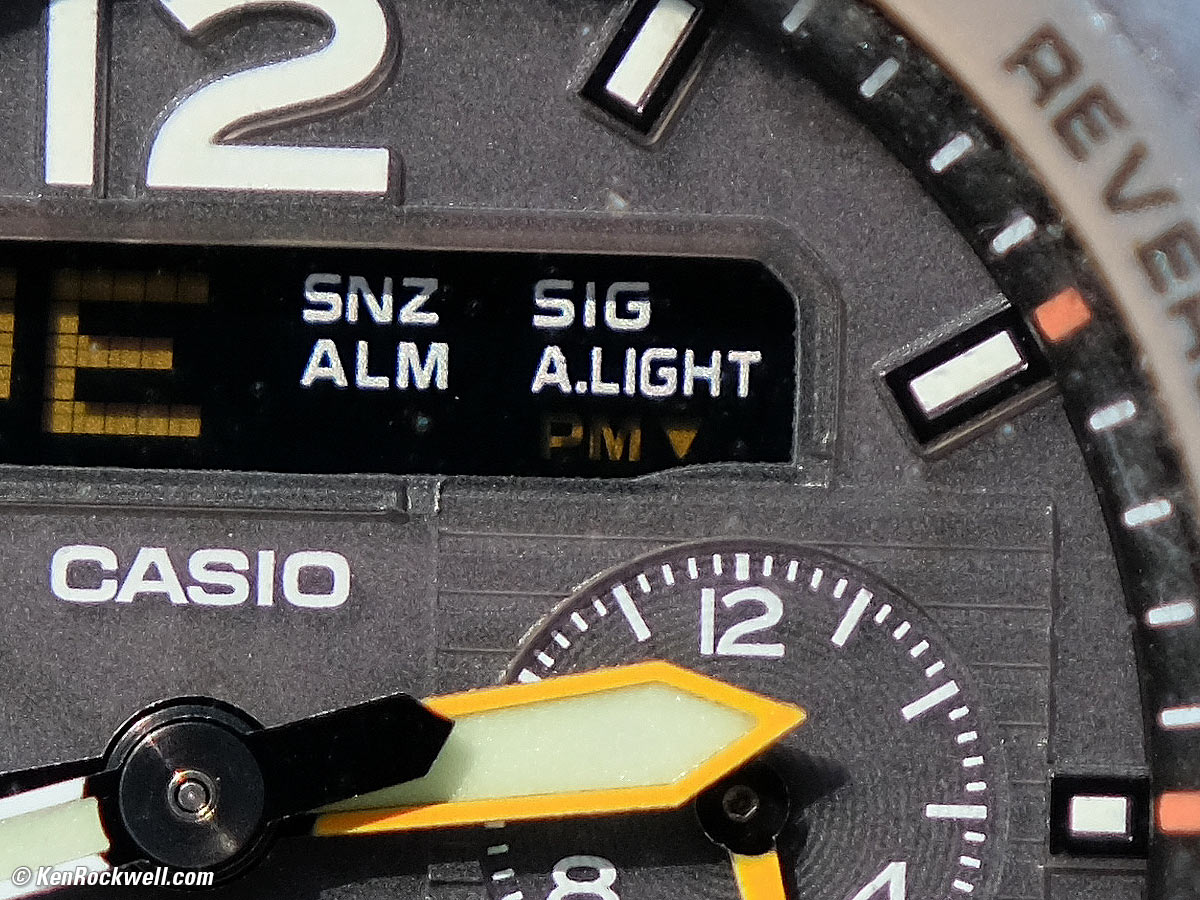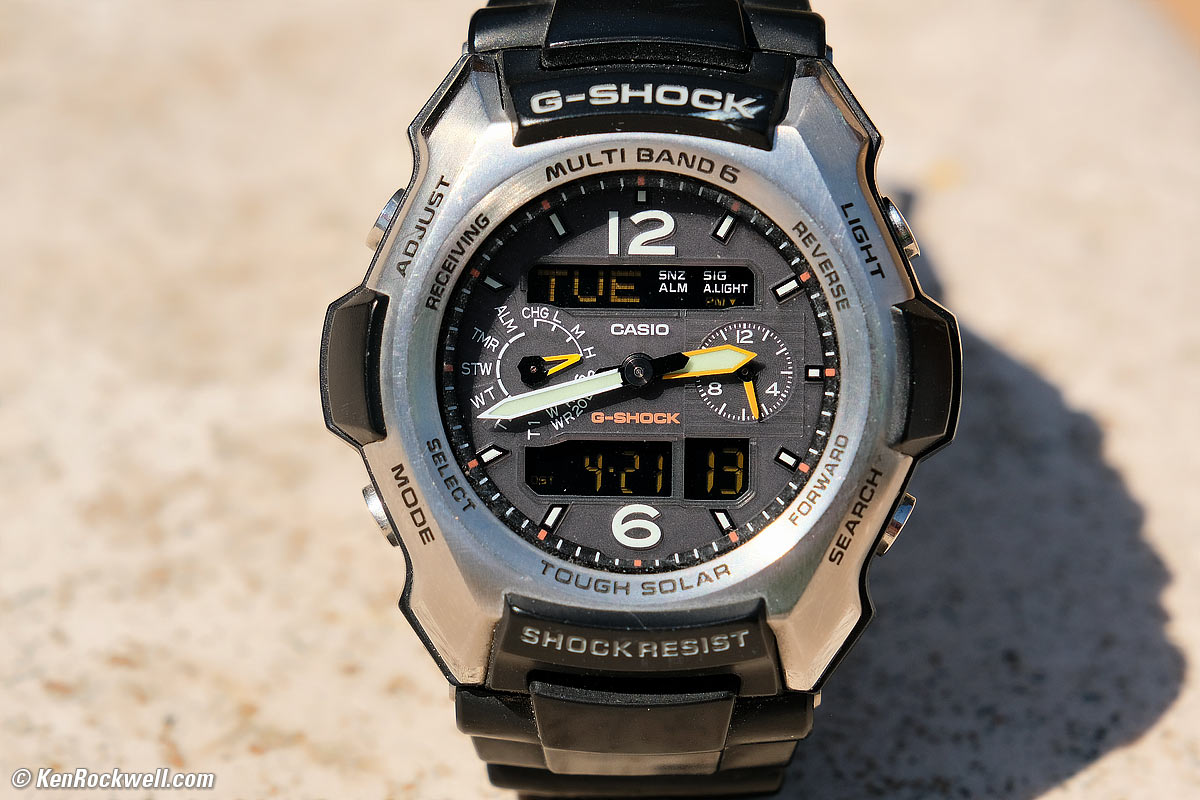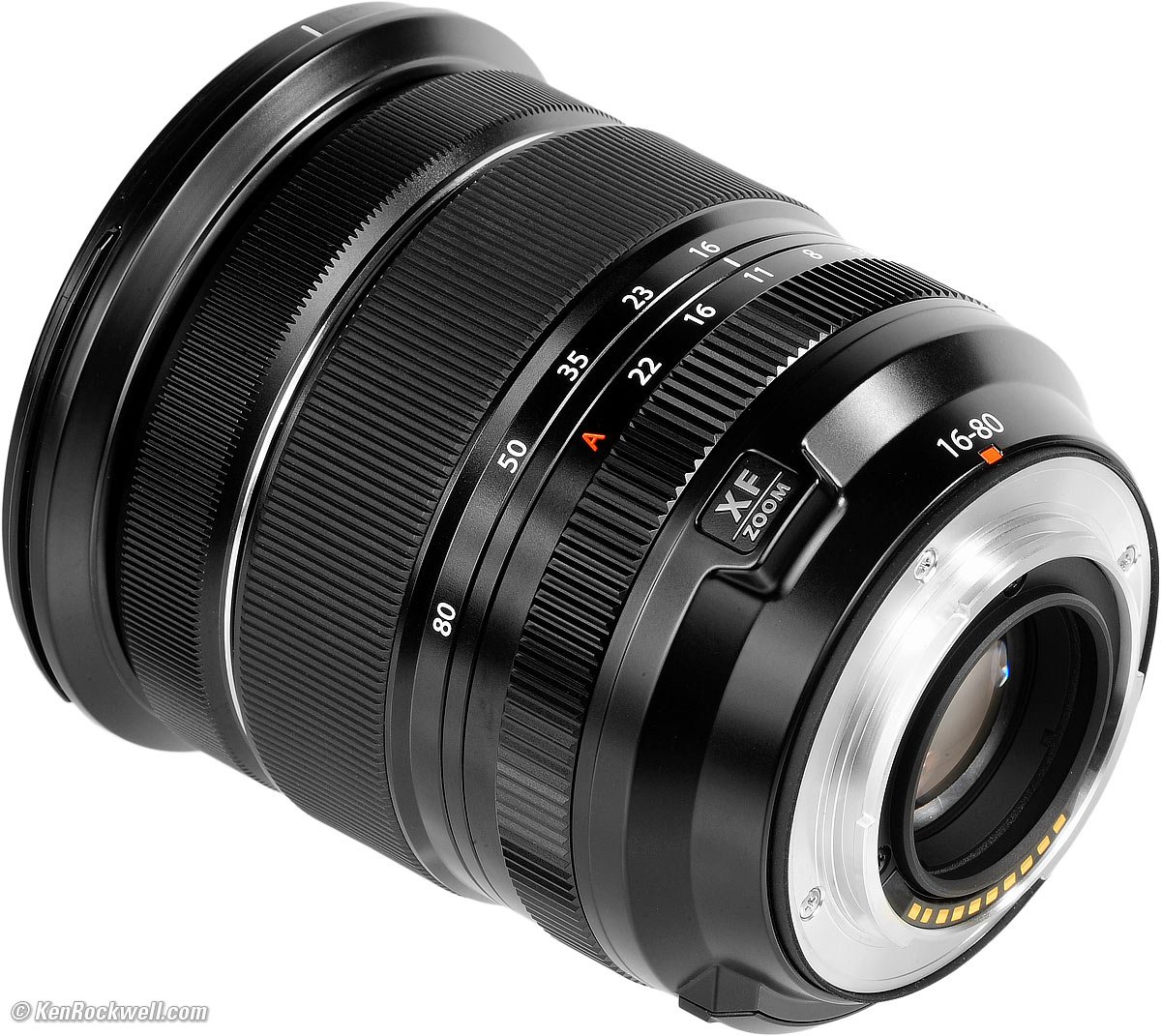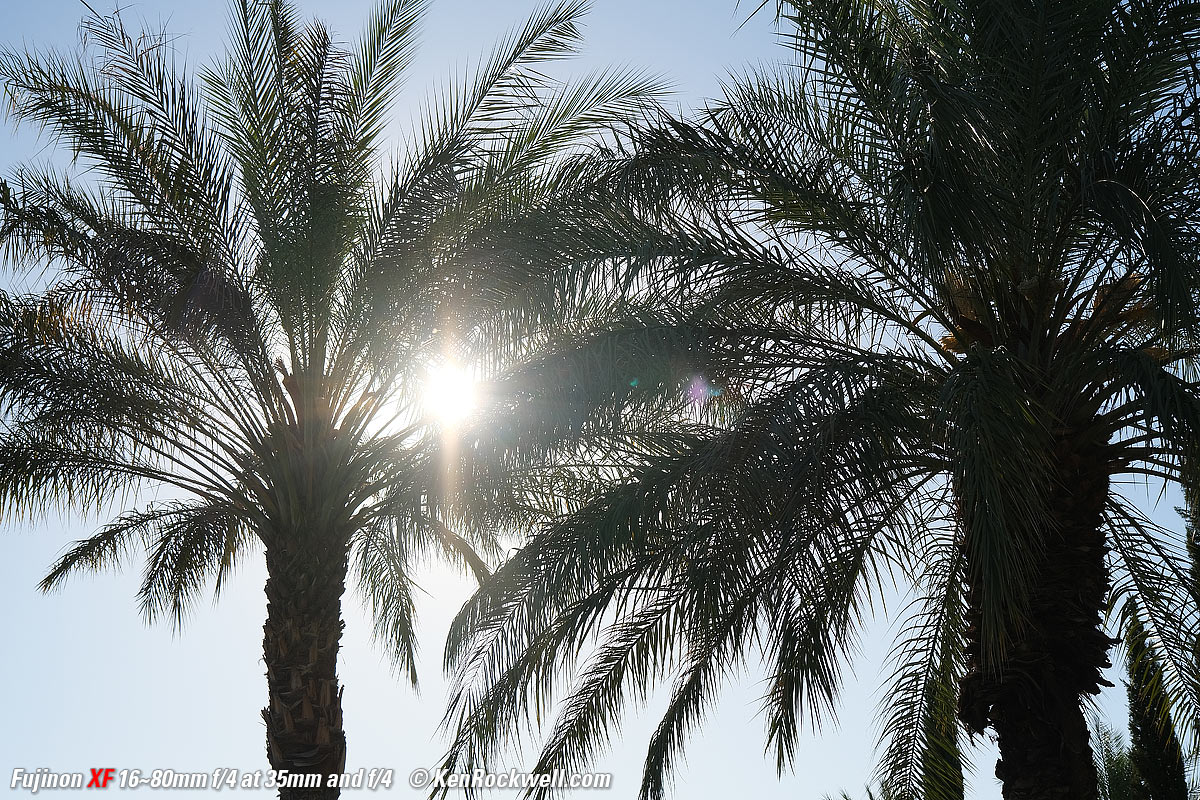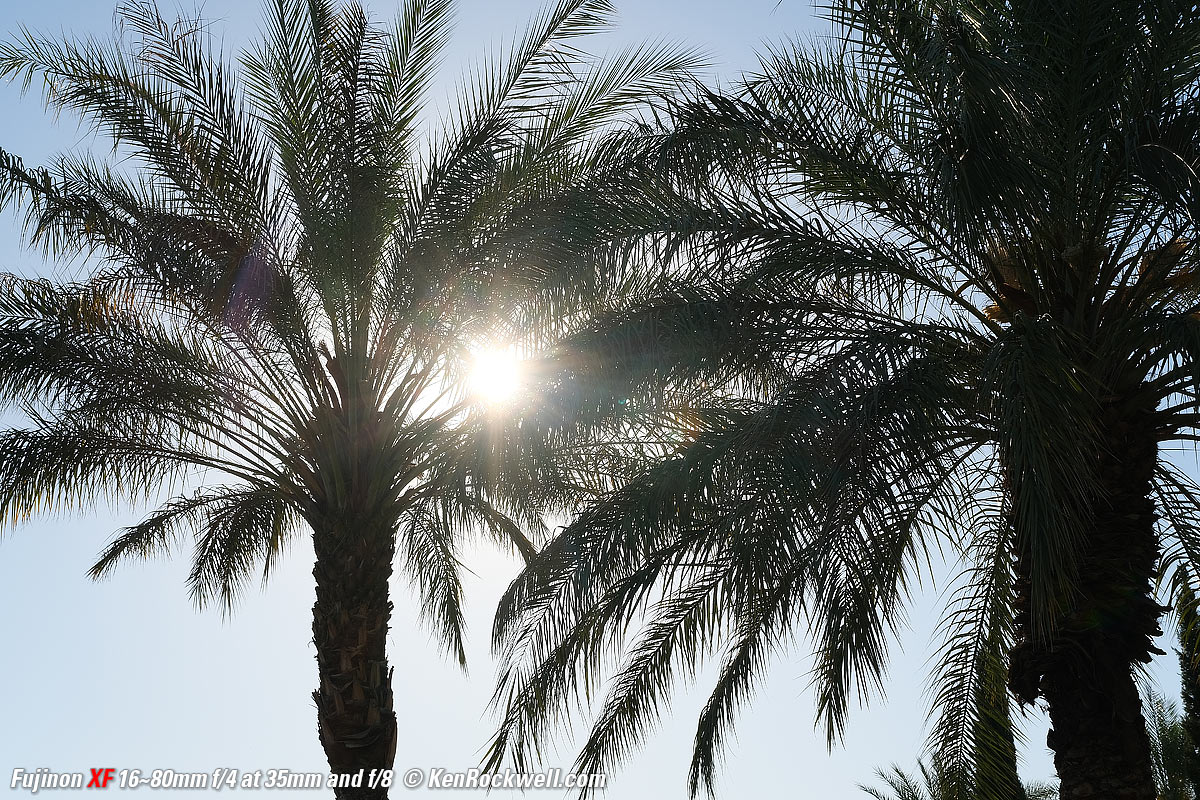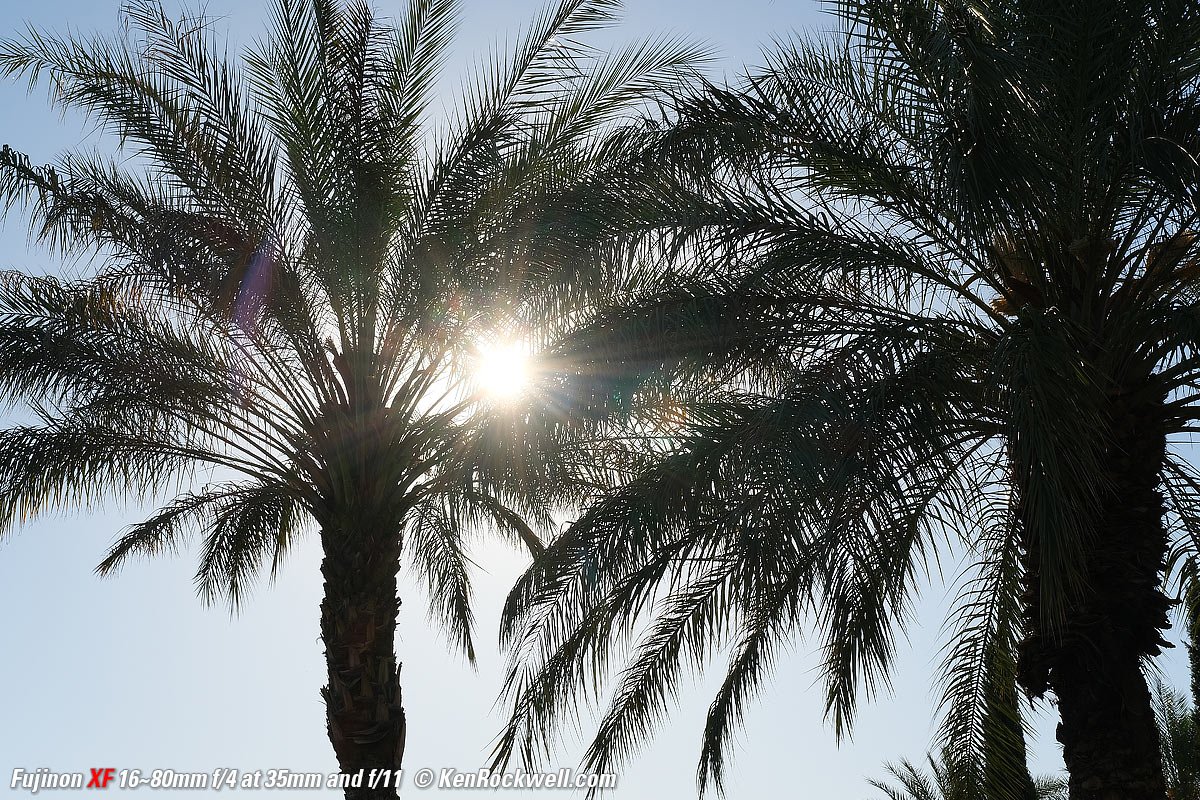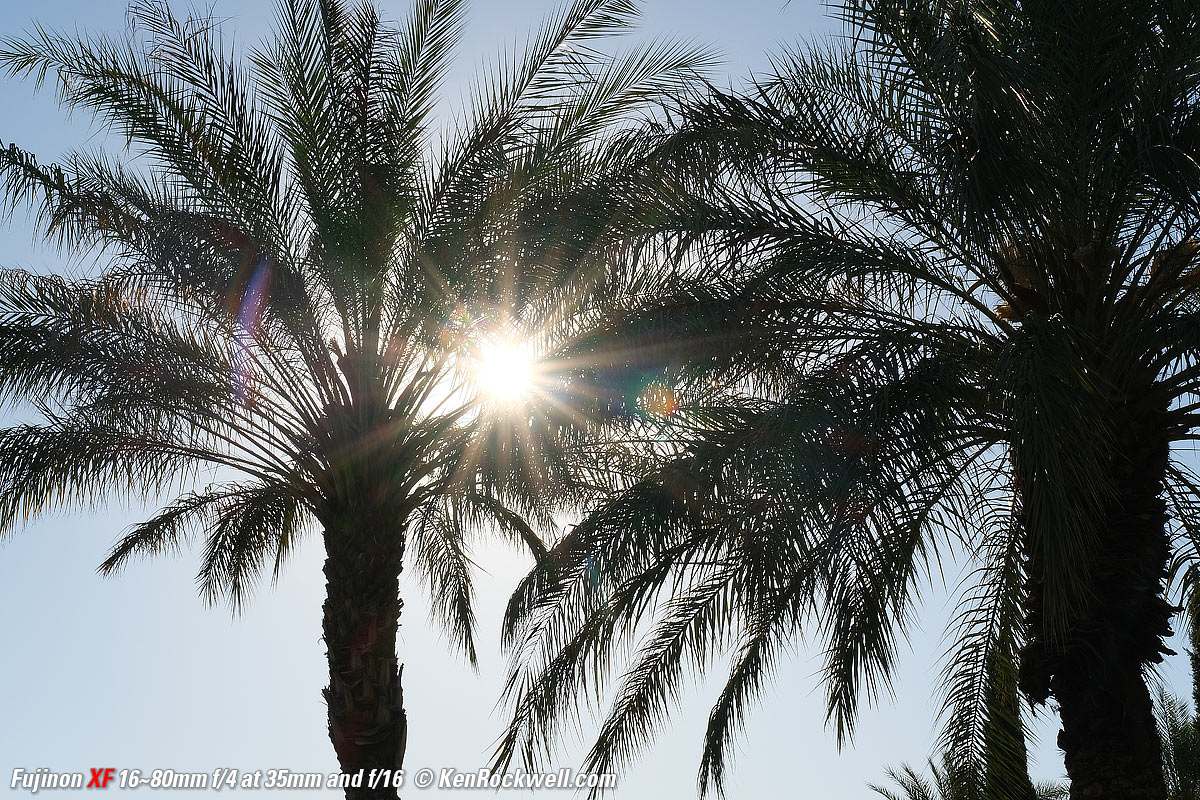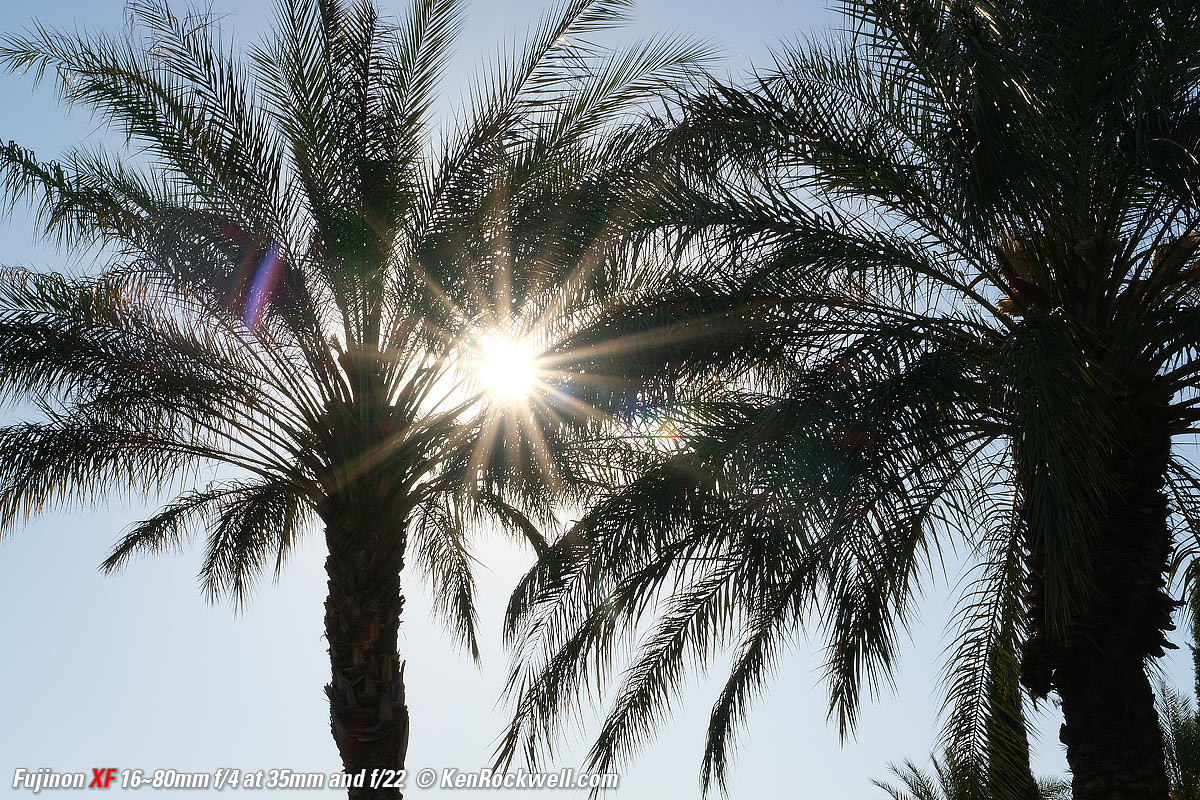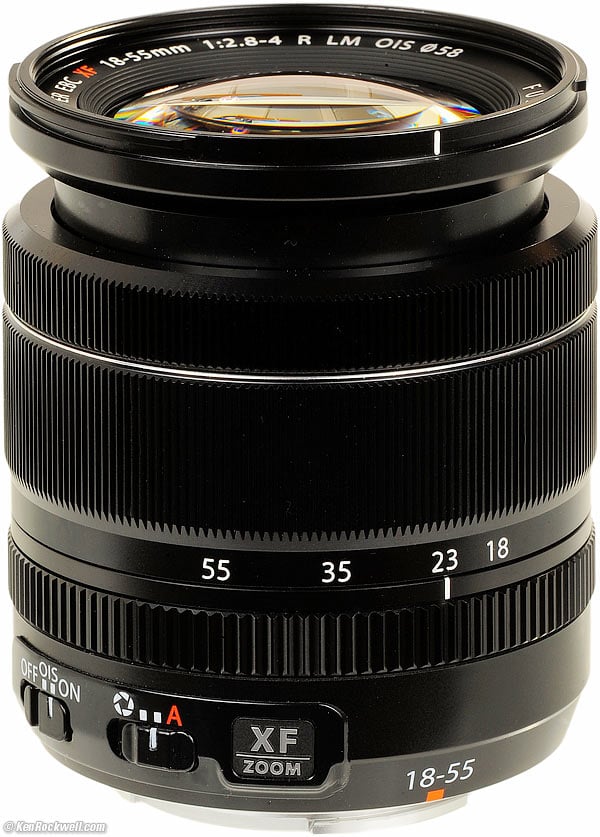Fuji 16-80mm f/4
Fujinon XF R OIS WR (24-120mm eq.)
Specifications Performance Compared
Fujinon XF 16-80mm f/4 R OIS WR (72mm filters, 15.5 oz./440 g, 1.1'/0.35m close focus, $799). bigger. I'd get mine at Adorama, at Amazon, at B&H or used at eBay if you know How to Win at eBay.
This all-content, junk-free website's biggest source of support is when you use those or any of these links to approved sources when you get anything, regardless of the country in which you live. Thanks for helping me help you! Ken.
May 2020 Better Pictures Fuji Fuji Lenses Sony LEICA Zeiss Nikon Canon All Reviews
Sample Images top
Specifications Performance Compared
These are just snapshots and there are many more throughout the review; my real work is in my Gallery.
These are all shot hand-held as NORMAL JPGs; no tripods, FINE JPGs or RAW files were used or needed. (the Fuji X-T30 can shoot raw files if you want them). All colors and exposures are exactly as these JPGs came out of my X-T30; images below may have been cropped and of course resized to fit the page.
Palm Drive, 6:54 PM, 21 April 2020. Fuji X-T30, Fuji XF 16-80mm f/4 at 48mm at f/5 at 1/125 at Auto ISO 320 (LV 10), Auto Dynamic Range chose 200%, as-shot except for perspective correction and cropping in Photoshop CS6. bigger or camera-original © JPG file.
Palm Desert Palms, 7:10 PM, 22 April 2020. Fuji X-T30, Fuji XF 16-80mm f/4 at 80mm at f/6.4 at 1/1,400 at Auto ISO 320 (LV 14.2), Auto Dynamic Range chose 200%, as-shot. bigger or camera-original © JPG file.
Desert Rotunda, 6:08 PM, 23 April 2020. Fuji X-T30, Fuji XF 16-80mm f/4 at 45mm at f/6.4 at 1/1,300 at Auto ISO 320 (LV 14.0), Auto Dynamic Range chose 200%, as-shot. bigger or camera-original © JPG file.
Yellow Street Triangle, 7:50 AM, 25 April 2020. Fuji X-T30, Fuji XF 16-80mm f/4 at 38mm at f/5.6 at 1/450 at Auto ISO 160 (LV 13.2), Auto Dynamic Range chose 100%, as-shot. bigger or camera-original © JPG file.
Introduction top
Specifications Performance Compared
|
I buy only from these approved sources. I can't vouch for ads below. |
This Fuji 16-80mm is a general-purpose zoom. It goes a little wider and longer than the smaller 18-55mm f/2.8-4, but this 16-80mm is bigger and more expensive. It's made of metal and plastic.
This 16-80mm is super sharp, as almost all lenses are today, and it also gets very close, probably replacing a macro lens for most people.
I'd get my 16-80mm at Adorama, at Amazon, at B&H or used at eBay if you know How to Win at eBay.
Fujinon XF 16-80mm f/4 R OIS WR. bigger.
Good
 Great optics, as most lenses today.
Great optics, as most lenses today.
 No focus breathing.
No focus breathing.
 Weather Resistant (that's the "WR" moniker):
Weather Resistant (that's the "WR" moniker):
Fuji 16-80mm Weather Seals.
 Constant f/4 aperture (but I prefer the variable f/2.8-4 of the 18-55mm).
Constant f/4 aperture (but I prefer the variable f/2.8-4 of the 18-55mm).
 Extremely useful zoom range.
Extremely useful zoom range.
 Dedicated aperture ring.
Dedicated aperture ring.
 Metal mount, focus, zoom and aperture rings.
Metal mount, focus, zoom and aperture rings.
 Rated to work down to -10º C (14º F).
Rated to work down to -10º C (14º F).
 Image Stabilization claims six stops of stabilization.
Image Stabilization claims six stops of stabilization.
 Image Stabilization claims to be smart enough to turn off on a tripod and adapt automatically for panning.
Image Stabilization claims to be smart enough to turn off on a tripod and adapt automatically for panning.
Bad
 Offshored to The Philippines; not made domestically in Japan.
Offshored to The Philippines; not made domestically in Japan.
Missing
 No Image Stabilization switch on the lens. Claims to be smart enough to turn off on a tripod and adapt automatically for panning all automatically.
No Image Stabilization switch on the lens. Claims to be smart enough to turn off on a tripod and adapt automatically for panning all automatically.
 No aperture-ring lock at A, making it easy to knock it to f/22 which could spoil a day's shooting if unnoticed.
No aperture-ring lock at A, making it easy to knock it to f/22 which could spoil a day's shooting if unnoticed.
Specifications top
Specifications Performance Compared
I'd get my 16-80mm at Adorama, at Amazon, at B&H or used at eBay if you know How to Win at eBay.
Name specifications top
Fujifilm calls this the Fujinon Aspherical Lens Super EBC XF 16-80mm f/4 R OIS WR ∅ 72:
Fujinon is Fujifilm's brand name for all their lenses, scopes and binoculars.
Aspherical means it uses aspherically-shaped lens elements for sharper pictures.
Super EBC is Fujinon's brand of multicoating, standing for Super Electron-Beam Coated.
XF is Fuji's line of good lenses for their X-mount cameras.
R means it has an aperture ring.
OIS means Optical Image Stabilization.
WR means weather resistant.
∅ 72 means it takes 72mm filters.
Optics specifications top
Fujinon internal optical construction. Aspherical and Aspherical ED elements.
16 elements in 12 groups.
One Aspherical ED extra-low dispersion element, which helps reduce secondary axial chromatic aberration.
Three aspherical elements.
Super Electron-Beam (multi) Coating (EBC).
Filters specifications top
Plastic 72mm filter thread.
Diaphragm specifications top
Fujinon XF 16-80mm f/4 R OIS WR. bigger.
9 rounded blades.
Electronically actuated.
Stops down to f/22 in 1/3-stop clicks.
Focal Length specifications top
16-80mm.
On Fujifilm's APS-C cameras it sees the same angles of view as a 24-120 mm lens sees when used on a 35mm camera.
See also Crop Factor.
Angles of View specifications top
83.2º ~ 20.1º diagonal on Fujifilm's APS-C cameras.
Autofocus specifications top
Internal focussing with an STM stepper motor.
No external movement as focussed.
Focus Scale specifications top
Not on lens, but may be displayed in-camera.
Infinity Focus Stop specifications top
No.
Depth of Field Scale specifications top
Not on lens, but may be displayed in-camera.
Infrared Focus Index specifications top
No.
Close Focus specifications top
1.15 feet (0.35 meters).
Maximum Reproduction Ratio specifications top
1:4 (0.25 ×).
Reproduction Ratio Scale specifications top
No.
Image Stabilizer specifications top
Rated six stops improvement.
Caps specifications top
72mm front lens cap (p/n 16451706).
RLCP-001 rear lens cap (p/n 16389783).
Hood specifications top
Hood, Fujinon XF 16-80mm f/4 R OIS WR. bigger.
Plastic bayonet hood, included.
Case specifications top
None.
Size specifications top
3.08" ø maximum diameter × 3.50" extension from flange.
78.3 mm ø maximum diameter × 88.9 mm extension from flange.
Weight specifications top
15.5 oz. (440 g).
Quality specifications top
Made in The Philippines.
Environment specifications top
Rated to work down to -10º C (+14º F).
Announced specifications top
18 July 2019.
Included specifications top
72mm front lens cap (p/n 16451706).
Plastic bayonet hood.
RLCP-001 rear lens cap (p/n 16389783).
Printed manual.
Packaging specifications top
Box, Fujinon XF 16-80mm f/4 R OIS WR. bigger.
Fujifilm's Model Numbers specifications top
16635613.
XF16-80mmF4 R OIS WR.
Price, USA specifications top
$799, May 2020.
Performance top
Specifications Performance Compared
Overall Autofocus Manual Focus Breathing Bokeh
Distortion Ergonomics Eyeblow Falloff Filters
Flare & Ghosts Lateral Color Fringes Macro
Mechanics Sharpness Spherochromatism Sunstars
I'd get my 16-80mm at Adorama, at Amazon, at B&H or used at eBay if you know How to Win at eBay.
Overall performance top
The 16-80mm is a straight-ahead lens; it's sharp, handles well and just works as it should.
Autofocus performance top
Autofocus is as fast as every other lens on my Fujifilm cameras; AF speed is at least as much dependant on your camera as it is on the motors in the lens.
Manual Focus performance top
Manual focus is the usual from Fujifilm: it's entirely electronic.
The manual focus ring isn't connected to anything other than a digital encoder.
Focus Breathing performance top
Focus breathing is the image changing size as focused in and out. It's important to cinematographers that the image not breathe because it looks funny if the image changes size as focus gets pulled back and forth between actors. If the lens does this, the image "breathes" by growing and contracting slightly as the dialog goes back and forth.
I can't see any breathing; this is much better than usual performance.
Bokeh performance top
Bokeh, the feel, character or quality of out-of-focus areas as opposed to how far out of focus they are, is good to neutral.
Here are photos from headshot distance wide-open:
Made-in-USA Davis 6250 weather station, 21 April 2020. Click any for the camera-original © JPG files.
As always, if you want to throw the background as far out of focus as possible, shoot at f/4 at 80mm and get as close as possible.
Distortion performance top
This lens has very little distortion. The weirdest thing is that it's about the same with the Digital Lens Modulation Optimizer ON or OFF, but that it's different. Weird.
These aren't facts or specifications, they are the results of my research that requires hours of photography and calculations on the resulting data.
at 10' (3m) |
Correction factor to use with images made with Fuji X-T30's Digital Lens Optimizer ON (default) |
Correction factor with uncorrected images |
16mm |
-0.20* | -1.00* |
24mm |
-1.80* | -1.00* |
35mm |
-0.60 | -0.30 |
50mm |
±0.00 | +0.50 |
80mm |
+0.30 | +0.50 |
© 2020 KenRockwell.com. All rights reserved.
* Slight waviness remains.
Ergonomics performance top
At 16mm. bigger. |
At 80mm. bigger. |
At 16mm. bigger. |
At 80mm. bigger. |
Ergonomics are the usual from Fuji's XF lenses.
The hard metal focus ring is purely electronic. It works in some modes and not in others, a typical failing in all mirrorless cameras other than Nikon's.
The zoom ring stops at 16mm and 80mm are a little softer than usual; it almost feels as if they're padded rather than just hard metal stops.
The metal aperture ring is a nice thought, but, as many of Fuji's lenses, has no deeper detents at the full stops, making setting by feel more difficult. Worse, all the detents are so weak that they are difficult to feel as you turn the ring, almost as if the designer had no idea that detents are to let you set this by feel.
There is no aperture ring lock at A, so it's easy to knock it accidentally to f/22 without knowing, which could screw up a day's shooting if it goes unnoticed.
The little red-painted lens mounting index is almost invisible, and can't be found by feel; so usually you just jam the lens into the camera and twist until it hooks-up; that's faster than trying to find the index and do it properly. So sad how lens makers have forgotten why these things are there!
Once you do get it oriented, it twists very smoothly as you mount it.
Eyeblow performance top
The 16-80 pumps so much air in and out as zoomed that I can feel air blowing on my eye from the eyepiece of my X-T30. Regardless of all the claims of dust sealing, you have to realize that the air has to go somewhere as the lens is zoomed and pumps in and out, and that air pumps in and out of the camera body, along with whatever dust is around.
Falloff performance top
Falloff is invisible. It looks the same, which is invisible, with or without the camera's Digital Lens Optimizer active.
I've greatly exaggerated the falloff by shooting a gray field and placing these on a gray background; it will not look this bad in actual photos of real things:
Fujinon 16-80mm Falloff.
© 2020 KenRockwell.com. All rights reserved. |
Filters, use with performance top
There's no need for thin filters. I can stack at least two standard 72mm filters without vignetting at every setting.
Go ahead and use your standard rotating polarizer and grad filters.
Be careful with polarizers at the 16mm setting because the sky's natural polarization can appear as a dark band across the sky. This isn't caused by the lens; it's caused by the sky.
Flare & Ghosts performance top
There are no problems with ghosts or flare; see Sunstars for samples.
Lateral Color Fringes performance top
There are no lateral color fringes as shot on Fujifilm's cameras, with or without the camera's Digital Lens Optimizer active.
Spherochromatism is a different aberration in a different dimension.
Macro Performance performance top
Macro performance is excellent. It gets very close, and it's sharp even wide-open:
At f/4
f/4 is pretty sharp; of course there's nothing in focus this close at f/4 due to the vapor-thin depth of field. There is some minor spherochromatism which can lead to color fringes on contrasty lines that aren't in perfect focus.
Mondaine A132.30348.11SBB at close-focus distance at 80mm at f/4, 21 April 2020. bigger or camera-original © file.
1,200 × 900 pixel crop from above. bigger or camera-original © file.
If this 1,200 × 900 pixel crop is about 3" (7.5cm) wide on your phone, then the complete image printed at this same extreme magnification would be about 11 × 16" (0.9 × 1.3 feet or 25 × 40 cm).
If this 1,200 × 900 pixel crop is about 6" (15cm) wide on your screen, then the complete image printed at this same extreme magnification would be about 21 × 31" (1.7 × 2.6 feet or 50 × 80 cm).
If this 1,200 × 900 pixel crop is about 12" (30cm) wide on your screen, then the complete image printed at this same extreme magnification would be about 42 × 62" (3.5 × 5.2 feet or 1.05 × 1.6 meters).
At f/8
It gets even sharper at f/8, and of course more is in focus:
Mondaine A132.30348.11SBB at close-focus distance at 80mm at f/8, 21 April 2020. bigger or camera-original © file.
1,200 × 900 pixel crop from above. bigger or camera-original © file.
If this 1,200 × 900 pixel crop is about 3" (7.5cm) wide on your phone, then the complete image printed at this same extreme magnification would be about 11 × 16" (0.9 × 1.3 feet or 25 × 40 cm).
If this 1,200 × 900 pixel crop is about 6" (15cm) wide on your screen, then the complete image printed at this same extreme magnification would be about 21 × 31" (1.7 × 2.6 feet or 50 × 80 cm).
If this 1,200 × 900 pixel crop is about 12" (30cm) wide on your screen, then the complete image printed at this same extreme magnification would be about 42 × 62" (3.5 × 5.2 feet or 1.05 × 1.6 meters).
Mechanical Quality performance top
Fujinon XF 16-80mm f/4 R OIS WR. bigger.
This is typical for Fuji's Lenses, a decent mix of plastic and metal.
Hood
Plastic bayonet.
Front Bumper
None.
Filter Threads
Plastic.
Hood Bayonet Mount
Plastic
Front Barrel
Plastic.
Focus Ring
Metal.
Zoom Ring
Rubber-covered metal.
Aperture Ring
Metal.
Rear Barrel Exterior
Plastic.
Identity
Engraved and filled with paint on ring between front element and filter threads.
Also on a sticker near the rear.
Internals
Plastic with some metal.
Dust Gasket at Mount
Yes.
Mount
Dull chromed metal.
Mounts very smoothly; not gritty or grabby at all.
Markings
Engraved and filled with paint on lens front ID ring, zoom and aperture rings.
Painted on plastic rear-most barrel.
Serial Number
Sticker glued on bottom of the lens barrel, neither an acceptable nor a permanent way to do this for a product that's handled all day.
Date Code
None found.
Noises When Shaken
Mild to moderate clunking.
Made in
Made in The Philippines.
Sharpness performance top
Lens sharpness has nothing to do with picture sharpness; every lens made in the past 100 years is more than sharp enough to make super-sharp pictures if you know what you're doing. The only limitation to picture sharpness is your skill as a photographer. It's the least talented who spend the most time worrying about lens sharpness and blame crummy pictures on their equipment rather than themselves. Skilled photographers make great images with whatever camera is in their hands; I've made some of my best images of all time with an irreparably broken camera! Most pixels are thrown away before you see them, but camera makers don't want you to know that.
If you're not getting ultra-sharp pictures with this, be sure not to shoot at f/11 or smaller where all lenses are softer due to diffraction, always shoot at ISO 200 or below because cameras become softer at ISO 320 and above, avoid shooting across long distances over land which can lead to atmospheric heat shimmer, be sure everything is in perfect focus, set your camera's sharpening as you want it (I set mine to the maximum) and be sure nothing is moving, either camera or subject. If you want to ensure a soft image with any lens, shoot at f/16 at ISO 1,600 at default sharpening in daylight of subjects at differing distances in the same image.
This said, my 16-80mm is super-sharp from corner to corner at every setting, diffraction and photographer errors notwithstanding. No problems here; this lens is more than superb for today's 26 MP cameras.
Spherochromatism performance top
Spherochromatism, also called secondary spherical chromatic aberration, is an advanced form of spherical and chromatic aberration in a different dimension than lateral chromatic aberration. It happens in fast lenses when spherical aberration at the ends of the spectrum are corrected differently than in the middle of the spectrum. Spherochromatism can cause colored fringes on out-of-focus highlights, usually seen as green fringes on backgrounds and magenta fringes on foregrounds. Spherochromatism is common in fast lenses of moderate focal length when shooting contrasty items at full aperture. It goes away as stopped down.
This 16-80mm has just a little bit of spherochromatism, not enough to worry about. You can see a tiny bit at the f/4 example at Macro Performance.
Sunstars performance top
With a 9-bladed rounded diaphragm, I get soft 18-pointed sunstars on brilliant points of light only at the smallest apertures. This is typical; sunstars rarely happen unless you really go out of your way to excite them.
Ignore the vertical smear at f/4; it's a sensor artifact called interline transfer smear; it's not a lens defect.
Click any to enlarge:
Compared top
Specifications Performance Compared
Overall
All these lenses are as sharp and focus about as fast; it's only the least experienced who spend the most time worrying about lens sharpness. It's not 1958 anymore when lots of lenses were often soft at larger apertures; today all these lenses are ultra sharp.
Versus the XC 15-45mm PZ OIS23-68mm equivalent, 52mm filters, 4.6 oz./131g, 0.42 feet (5.1" or 0.13 meters) close focus at 15mm setting and 1.15 feet (13.8" or 0.35 meters) close focus at 45mm setting. The XC 15-45mm PZ OIS is a tiny, weightless all-plastic "power zoom" that's just as sharp. The 15-45mm is best for traveling light and if you don't beat on the lens all day professionally. |
Versus the XF 16-55mm f/2.8 R LM WR24-85mm equivalent, metal 77mm filter thread, 23.2 oz./657g, 1'/0.3m close focus. The XF 16-55mm f/2.8 R LM WR is one stop faster for use in low light, but otherwise has a more restricted zoom range, weaker macro range, and is bigger, heavier and more expensive. The 16-55mm f/2.8 is the only lens here without stabilization. Try this if you really need f/2.8 if you live in the dark, otherwise I'd pass on this five-year-older beast of a lens. |
Versus the XF 18-55mm f/2.8-4 R LM OIS28-85mm equivalent, metal 58mm filter thread, 10.9 oz./309g, 1-1.3'/0.3-0.4 m close focus. The XF 18-55mm f/2.8-4 R LM OIS has been a favorite ever since it came out. It's as fast as the beastly 16-55mm f/2.8 at the wide end, and it's much smaller and lighter than this new 16-80mm. This 18-55mm f/2.8-4 doesn't have as tight a macro range and has a more restricted zoom range at both ends. The 18-55mm f/2.8-4 costs about the same as this lens. Get the 18-55mm f/2.8-4 if you value size and speed over zoom range and macro ability; get this newer 16-80mm if you don't mind a little extra size and weight in exchange for a more useful zoom and macro range. |
Versus the XF 18-135mm f/3.5-5.6 R LM OIS WR28-200mm equivalent, metal 67mm filter thread, 17.2 oz./487g, 1.5'/0.45m close focus. The XF 18-135mm f/3.5-5.6 R LM OIS WR offers a much longer zoom range and even tighter macro performance at about the the same size and weight for about $200 USD more, but is a stop slower at the long end. If you don't mind losing $200 and a stop at the long end, this is also a superb do-everything lens. |
Recommendations top
Specifications Performance Compared
This 16-80mm is an excellent do-everything, carry anywhere lens. It's optically superb (as are all of Fuji's Lenses), covers a great range, has great macro perform ace and is reasonably small and light. it claims superb stabilizer performance as well.
I use a clear (UV) protective filter instead of a cap so I'm always ready to shoot instantly. I only use a cap when I throw this in a bag with other gear without padding — which is never. The UV filter never gets in the way, and never gets lost, either.
The very best protective filter is the 72mm Hoya multicoated HD3 UV which uses hardened glass and repels dirt and fingerprints.
For less money, the B+W 72mm 010 is an excellent filter, as are the multicoated version and the basic multicoated Hoya filters, but the Hoya HD3 is the toughest and the best.
Filters last a lifetime, so you may as well get the best since it will be used on your future lenses. The Hoya HD3 stays cleaner than the others since it repels oil and dirt.
All these filters are just as sharp and take the same pictures, the difference is how much abuse they'll take and stay clean and stay in one piece.
I'd get my 16-80mm at Adorama, at Amazon, at B&H or used at eBay if you know How to Win at eBay.
This 100% all-content website's biggest source of support is when you use those or any of these links to approved sources when you get anything, regardless of the country in which you live. Fujifilm does not seal its boxes in any way, so never buy at retail or any other source not on my personally approved list since you'll have no way of knowing if you're missing accessories, getting a defective, damaged, returned, non-USA, store demo or used lens. I use the stores I do because they ship from secure remote warehouses where no one gets to touch your new camera before you do. Buy only from the approved sources I use myself for the best prices, service, return policies and selection.
Thanks for helping me help you!
Ken, Mrs. Rockwell, Ryan and Katie.
More Information top
Specifications Performance Compared
Fujifilm's 16-80mm Press Release.
© Ken Rockwell. All rights reserved. Tous droits réservés. Alle Rechte vorbehalten.
Help Me Help You
I support my growing family through this website, as crazy as it might seem.
The biggest help is when you use any of these links when you get anything. It costs you nothing, and is this site's, and thus my family's, biggest source of support. These places always have the best prices and service, which is why I've used them since before this website existed. I recommend them all personally.
If you find this page as helpful as a book you might have had to buy or a workshop you may have had to take, feel free to help me continue helping everyone.
If you've gotten your gear through one of my links or helped otherwise, you're family. It's great people like you who allow me to keep adding to this site full-time. Thanks!
If you haven't helped yet, please do, and consider helping me with a gift of $5.00.
As this page is copyrighted and formally registered, it is unlawful to make copies, especially in the form of printouts for personal use. If you wish to make a printout for personal use, you are granted one-time permission only if you PayPal me $5.00 per printout or part thereof. Thank you!
Thanks for reading!
Mr. & Mrs. Ken Rockwell, Ryan and Katie.
